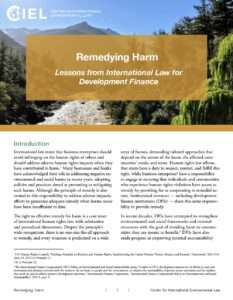
The right to effective remedy for harm is a core tenet of international human rights law, with substantive and procedural dimensions. Despite the principle’s wide recognition, there is no one-size-fits-all approach to remedy, and every situation is predicated on a wide array of factors, demanding tailored approaches that depend on the nature of the harm, the affected communities’ needs, and more.
The need to provide substantive remedy to persons and communities who have been harmed in the context of projects financed by development finance institutions (DFIs) is now receiving long-overdue attention within some leading development banks. As DFIs seek to chart a course to ensure access to remedy, they would do well to learn from the development of the concept of remedy over many decades in the field of international law and, in particular, in international human rights law.
This resource is presented with the hope and expectation that comparative examples and lessons learned from the field of international human rights law might illuminate ways for DFIs to establish rights-based frameworks for providing remedy. Remedying Harm: Lessons from International Law for Development Finance begins with a description of the concept of remedy, its origins in international law, its development in the field of human rights law specifically, and its centrality to the sub-field of business and human rights. The brief then analyzes the critical distinction between the procedural and substantive elements of remedy before delving into a deeper discussion of the latter element, which is particularly relevant for DFIs grappling with the issue of remedy today. It then lays out a typology of forms of remedy that have been applied by international bodies and tribunals, which DFIs should consider in seeking to ensure robust and effective responses to harms occurring in the context of projects they finance. Finally, it outlines how DFIs may apply existing best practices and relevant international standards to advance remedy, and it provides specific recommendations in this regard.
Published on March 10, 2022
